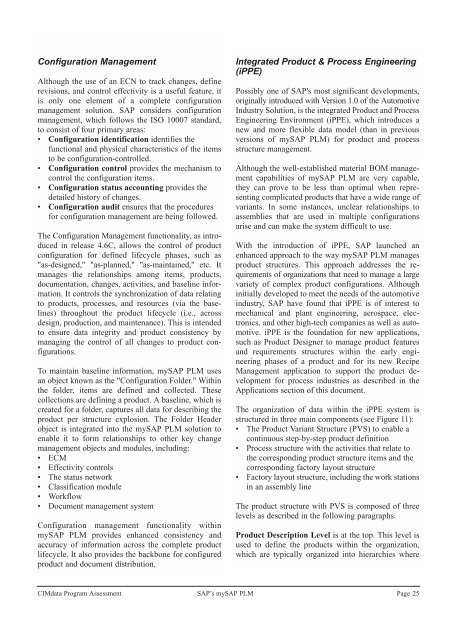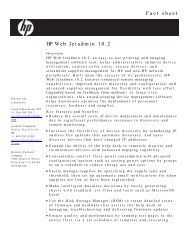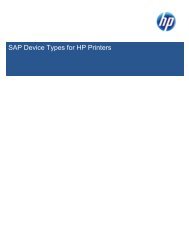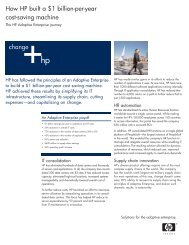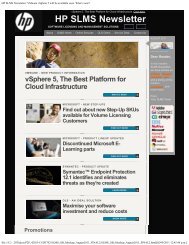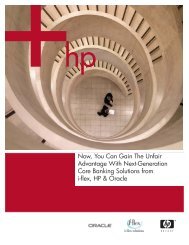CIMdata review on SAP's PLM cPDm program (PDF) - Large ...
CIMdata review on SAP's PLM cPDm program (PDF) - Large ...
CIMdata review on SAP's PLM cPDm program (PDF) - Large ...
Create successful ePaper yourself
Turn your PDF publications into a flip-book with our unique Google optimized e-Paper software.
C<strong>on</strong>figurati<strong>on</strong> Management<br />
Although the use of an ECN to track changes, define<br />
revisi<strong>on</strong>s, and c<strong>on</strong>trol effectivity is a useful feature, it<br />
is <strong>on</strong>ly <strong>on</strong>e element of a complete c<strong>on</strong>figurati<strong>on</strong><br />
management soluti<strong>on</strong>. SAP c<strong>on</strong>siders c<strong>on</strong>figurati<strong>on</strong><br />
management, which follows the ISO 10007 standard,<br />
to c<strong>on</strong>sist of four primary areas:<br />
• C<strong>on</strong>figurati<strong>on</strong> identificati<strong>on</strong> identifies the<br />
functi<strong>on</strong>al and physical characteristics of the items<br />
to be c<strong>on</strong>figurati<strong>on</strong>-c<strong>on</strong>trolled.<br />
• C<strong>on</strong>figurati<strong>on</strong> c<strong>on</strong>trol provides the mechanism to<br />
c<strong>on</strong>trol the c<strong>on</strong>figurati<strong>on</strong> items.<br />
• C<strong>on</strong>figurati<strong>on</strong> status accounting provides the<br />
detailed history of changes.<br />
• C<strong>on</strong>figurati<strong>on</strong> audit ensures that the procedures<br />
for c<strong>on</strong>figurati<strong>on</strong> management are being followed.<br />
The C<strong>on</strong>figurati<strong>on</strong> Management functi<strong>on</strong>ality, as introduced<br />
in release 4.6C, allows the c<strong>on</strong>trol of product<br />
c<strong>on</strong>figurati<strong>on</strong> for defined lifecycle phases, such as<br />
"as-designed," "as-planned," "as-maintained," etc. It<br />
manages the relati<strong>on</strong>ships am<strong>on</strong>g items, products,<br />
documentati<strong>on</strong>, changes, activities, and baseline informati<strong>on</strong>.<br />
It c<strong>on</strong>trols the synchr<strong>on</strong>izati<strong>on</strong> of data relating<br />
to products, processes, and resources (via the baselines)<br />
throughout the product lifecycle (i.e., across<br />
design, producti<strong>on</strong>, and maintenance). This is intended<br />
to ensure data integrity and product c<strong>on</strong>sistency by<br />
managing the c<strong>on</strong>trol of all changes to product c<strong>on</strong>figurati<strong>on</strong>s.<br />
To maintain baseline informati<strong>on</strong>, mySAP <strong>PLM</strong> uses<br />
an object known as the "C<strong>on</strong>figurati<strong>on</strong> Folder." Within<br />
the folder, items are defined and collected. These<br />
collecti<strong>on</strong>s are defining a product. A baseline, which is<br />
created for a folder, captures all data for describing the<br />
product per structure explosi<strong>on</strong>. The Folder Header<br />
object is integrated into the mySAP <strong>PLM</strong> soluti<strong>on</strong> to<br />
enable it to form relati<strong>on</strong>ships to other key change<br />
management objects and modules, including:<br />
• ECM<br />
• Effectivity c<strong>on</strong>trols<br />
• The status network<br />
• Classificati<strong>on</strong> module<br />
• Workflow<br />
• Document management system<br />
C<strong>on</strong>figurati<strong>on</strong> management functi<strong>on</strong>ality within<br />
mySAP <strong>PLM</strong> provides enhanced c<strong>on</strong>sistency and<br />
accuracy of informati<strong>on</strong> across the complete product<br />
lifecycle. It also provides the backb<strong>on</strong>e for c<strong>on</strong>figured<br />
product and document distributi<strong>on</strong>.<br />
Integrated Product & Process Engineering<br />
(iPPE)<br />
Possibly <strong>on</strong>e of <strong>SAP's</strong> most significant developments,<br />
originally introduced with Versi<strong>on</strong> 1.0 of the Automotive<br />
Industry Soluti<strong>on</strong>, is the integrated Product and Process<br />
Engineering Envir<strong>on</strong>ment (iPPE), which introduces a<br />
new and more flexible data model (than in previous<br />
versi<strong>on</strong>s of mySAP <strong>PLM</strong>) for product and process<br />
structure management.<br />
Although the well-established material BOM management<br />
capabilities of mySAP <strong>PLM</strong> are very capable,<br />
they can prove to be less than optimal when representing<br />
complicated products that have a wide range of<br />
variants. In some instances, unclear relati<strong>on</strong>ships to<br />
assemblies that are used in multiple c<strong>on</strong>figurati<strong>on</strong>s<br />
arise and can make the system difficult to use.<br />
With the introducti<strong>on</strong> of iPPE, SAP launched an<br />
enhanced approach to the way mySAP <strong>PLM</strong> manages<br />
product structures. This approach addresses the requirements<br />
of organizati<strong>on</strong>s that need to manage a large<br />
variety of complex product c<strong>on</strong>figurati<strong>on</strong>s. Although<br />
initially developed to meet the needs of the automotive<br />
industry, SAP have found that iPPE is of interest to<br />
mechanical and plant engineering, aerospace, electr<strong>on</strong>ics,<br />
and other high-tech companies as well as automotive.<br />
iPPE is the foundati<strong>on</strong> for new applicati<strong>on</strong>s,<br />
such as Product Designer to manage product features<br />
and requirements structures within the early engineering<br />
phases of a product and for its new Recipe<br />
Management applicati<strong>on</strong> to support the product development<br />
for process industries as described in the<br />
Applicati<strong>on</strong>s secti<strong>on</strong> of this document.<br />
The organizati<strong>on</strong> of data within the iPPE system is<br />
structured in three main comp<strong>on</strong>ents (see Figure 11):<br />
• The Product Variant Structure (PVS) to enable a<br />
c<strong>on</strong>tinuous step-by-step product definiti<strong>on</strong><br />
• Process structure with the activities that relate to<br />
the corresp<strong>on</strong>ding product structure items and the<br />
corresp<strong>on</strong>ding factory layout structure<br />
• Factory layout structure, including the work stati<strong>on</strong>s<br />
in an assembly line<br />
The product structure with PVS is composed of three<br />
levels as described in the following paragraphs.<br />
Product Descripti<strong>on</strong> Level is at the top. This level is<br />
used to define the products within the organizati<strong>on</strong>,<br />
which are typically organized into hierarchies where<br />
<str<strong>on</strong>g>CIMdata</str<strong>on</strong>g> Program Assessment SAP’s mySAP <strong>PLM</strong> Page 25


